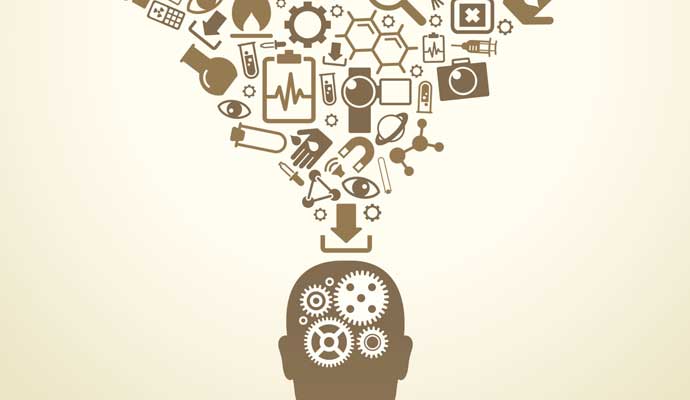Organizational Intelligence: What is it, and how can managers use it?
(originally published by Booz & Company)Just as we now measure the intelligence of people by using I.Q., the study of organizational intelligence measures the intellectual capacity of entire organizations -- what I call O.I.Q. Imagine being able to know that General Motors has an O.I.Q. of 85, I.B.M. is rated at 105 and Microsoft at 120.
I.Q. has been found to account for roughly 50 percent of the differences in human success, and I believe something similar is true of O.I.Q. Roughly half of corporate performance may be attributed to a company's capability for responding to change and complexity intelligently, with the rest being determined by dynamic factors: leadership, strategy and environmental conditions. (See box on page 11.)
Just as people, for various reasons, may not use their intelligence to succeed, organizations may not employ their intelligence if they do not have good leaders, clever strategies and a favorable environment.
Clearly there is great potential value for companies to be able to determine their O.I.Q. and where both their strengths and weaknesses lie in responding to change and complexity.
The recent spotlight on the importance of knowledge in corporate management is highlighted by studies estimating that the value of employee know-how, patents, brand names and other forms of knowledge rose from 38 percent of corporate assets in 1982 to 62 percent in 1992. In 1997, knowledge accounted for 80 percent of all corporate assets. However, these same studies show that managers believe only 20 percent of this vital resource is used.
At a time when exciting concepts such as organizational learning, knowledge management and intellectual assets are being put into use, there is little solid understanding of how to evaluate these practices, how they relate to performance and how they can be improved. Nor do we understand how knowledge is enhanced by information technology. Corporations have invested billions of dollars in information systems over the past decade, yet serious misgivings persist over the promised gains.
My associates and I have studied the Information Revolution for many years, recently focusing on the central role of organizational intelligence. We've developed a conceptual framework defining O.I., systems for measuring it and methods for analyzing its role in corporate performance.
What Is Organizational Intelligence?
Organizational intelligence is the capacity of an organization to create knowledge and use it to strategically adapt to its environment or marketplace. It is similar to I.Q., but framed at an organizational level.
While organizations in the past have been viewed as compilations
of tasks, products, employees, profit centers and processes, today they are increasingly seen as intelligent systems designed to manage knowledge. Scholars have shown that organizations engage in learning processes using tacit forms of intuitive knowledge, hard data stored in computer networks and information gleaned from the environment, all of which are used to make sensible decisions. Because this complex process involves large numbers of people interacting with diverse information systems, O.I. is more than the aggregate intelligence of organizational members; it is the intelligence of the organization itself as a larger system.
My work integrates this research into a comprehensive, more effective whole that builds on roughly the same approach used to characterize human intelligence, I.Q. The capacity for human problem solving is composed of several facets, such as "emotional intelligence" coupled with the more traditional form of "rational intelligence." In a similar way, I define organizational intelligence as the problem-solving capacity of an organization created by various subsystems.
These subsystems include organizational structure, culture, stakeholder relationships, knowledge assets and strategic processes, all of which are affected by I.T. in various ways. Each subsystem contributes to O.I. because it serves an essential purpose in the organization's cognitive functioning. What follows are some examples of these subsystems and the impact each has on the organization.
Structure: Bottom-Up Organizations Are Fast and Creative
Hierarchical organizational structures limit decisions to the higher echelons. But today, sophisticated I.T. systems permit flat organizations to use employee knowledge to solve operating problems more directly and quickly. Some companies, including MCI, Xerox, Johnson & Johnson, Hewlett-Packard and Motorola, have fully decentralized "bottom-up" structures. These firms are in turbulent industries rife with change, so they organize knowledge workers into self-managed units that are held accountable for performance and are then given wide operating freedom to choose their co-workers, hours, methods and all other aspects of their work.
Many companies make a point of accurately attributing economic cost and benefits, often designating staff units as profit centers that operate as "suppliers" or "consultants" serving their internal "clients," the line units. The result is an "internal market" offering the same benefits -- better decisions through updated price information, enhanced entrepreneurship and creativity, customer responsiveness -- as external markets. ABB's 4,500 independent profit centers have become a model of internal markets. Siemens and Lufthansa both have similar models.
Stakeholder Relations:
Cooperation Improves Communications
 If corporations are standoffish or hostile to their employees, customers, suppliers and other stakeholders, communication channels become blocked and distorted with disinformation. Conversely, good working relationships enhance the vital flow of valuable knowledge. From this view of O.I., therefore, cooperation with stakeholders is not simply "social responsibility" or "business ethics" -- it is a route to competitive advantage.
If corporations are standoffish or hostile to their employees, customers, suppliers and other stakeholders, communication channels become blocked and distorted with disinformation. Conversely, good working relationships enhance the vital flow of valuable knowledge. From this view of O.I., therefore, cooperation with stakeholders is not simply "social responsibility" or "business ethics" -- it is a route to competitive advantage.
Some companies unite all these alliances into complete "corporate communities." G.M., Saturn, the Body Shop and IKEA develop trusting relations with clients, share power with workers and cooperate with suppliers while also making better profits. Microsoft, Netscape and America Online have formed complete economic ecosystems to unite suppliers, manufacturers and distributors in a cluster of cooperating firms.
Knowledge Assets:
Information Increases When Shared
The pooling of information into a common repository that can be accessed by business units is the type of O.I. most companies currently focus on. Simply put: knowledge increases when shared.
A classic example is the system created by McGraw-Hill a few years ago. McGraw-Hill's C.E.O. created a corporate-wide information network to unify all business units into an "intellectual community," like a university or research lab. The central component was a knowledge base that pooled the information gathered by the units, which they could then draw on to serve their clients better. The knowledge base was aptly called an "information turbine" because it converted raw data into a stream of knowledge that "powered" the organization.
Here are some other prominent knowledge assets:
![]() Research Consortia. About 250 research consortia and 1,600 business-government research partnerships have been formed in the United States to pool knowledge. The auto industry alone has 12 consortia.
Research Consortia. About 250 research consortia and 1,600 business-government research partnerships have been formed in the United States to pool knowledge. The auto industry alone has 12 consortia.
![]() Business Functions. Hewlett-Packard has developed systems to share information on market intelligence, management practices and engineering data. I.B.M. uses a corporate intranet to provide business units with evaluations of suppliers and to consolidate all purchases.
Business Functions. Hewlett-Packard has developed systems to share information on market intelligence, management practices and engineering data. I.B.M. uses a corporate intranet to provide business units with evaluations of suppliers and to consolidate all purchases.
![]() Customer Service. Merrill Lynch helps its 18,000 account managers serve millions of clients world-wide with a computer network that stores the firm's knowledge about securities and financial forecasts. Andersen Consulting uses a global network to pool the best practices of its worldwide consulting business.
Customer Service. Merrill Lynch helps its 18,000 account managers serve millions of clients world-wide with a computer network that stores the firm's knowledge about securities and financial forecasts. Andersen Consulting uses a global network to pool the best practices of its worldwide consulting business.
How Can Managers Use O.I. To Improve Performance?
This work is still at an early stage, and so we are continuing to interview scholars and managers to improve our understanding of O.I., to refine methods for measuring it and explore the causal relationships involved. We're not yet ready to provide O.I.Q. scores for individual companies.
But it is clear already that measuring each of the components of O.I.Q. can determine the relative contribution of each to performance. From this we can gather a detailed analysis determining which systems are strong or weak. A low O.I.Q. could be traced to some particular problem, such as a hierarchical structure, suggesting precise improvements that could be made to raise O.I. and improve performance. The subsystems making up O.I. are relatively fixed, but unlike I.Q., O.I.Q. can be improved if managers will devote time, resources and effort to restructure them.
Obviously, there are limits to any measurement system, and all ratings can be misused if one does not bear these limitations in mind. However, we believe the ability to study O.I. may become as important as our present ability to study human intelligence.
Defining O.I.Q.
Organizational Intelligence is defined as the capacity of an organization to create knowledge and use it to strategically adapt to its environment. It is similar to I.Q., but framed at an organizational level. The mean is normalized at 100, so that an O.I.Q. above 100 indicates a more intelligent organization, whereas one below 100 indicates a less intelligent organization.
Information Technology and Systems are the technical networks carrying formal, hard information through the organization. I.T. systems with greater processing power and distributed architectures generally improve O.I.
Organizational Structure is defined as hierarchical versus decentralized decision-making. Decentralized organizations raise O.I. because they permit faster, local decisions.
Organizational Culture consists of the symbols, ceremonies and the normative climate of the organization. Generally speaking, entrepreneurial cultures seem to correspond with higher O.I.
Stakeholder Relationships between interest groups play an important role in O.I. because cooperative relationships increase the flow of knowledge.
Knowledge Assets are the intellectual capital of the organization: patents, data bases and the knowledge of members. Information-rich companies usually behave more intelligently.
Strategic Processes gather information and convert it into strategic decisions. Wide participation is usually more effective because more information is used to reach better decisions.
Dynamic Factors such as leadership, strategy and environmental conditions are prone to change, in contrast to the other factors that make O.I. an enduring and relatively fixed capability.
Performance is defined as the organization's ability to meet economic standards of profitability, market share and so on. ![]()


